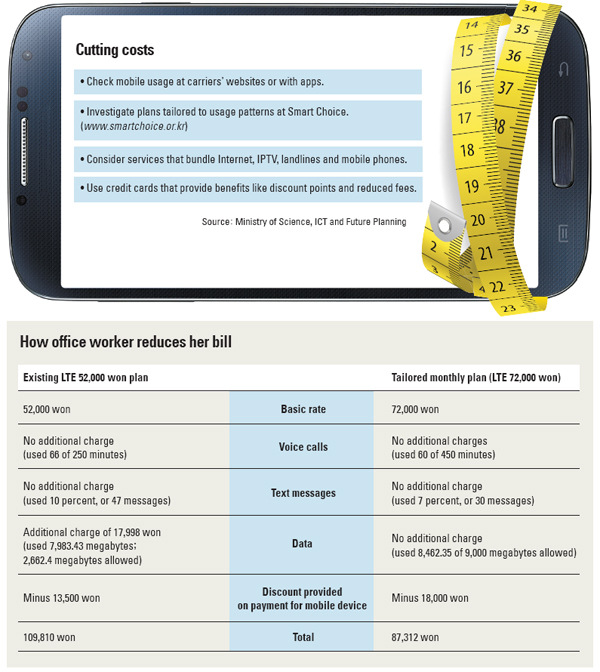Mobile costs go through the roof

The figure as of Jan. 15 represents the average monthly communications cost for two-person households, according to Statistics Korea. It is 20 percent higher than in 2008 and the third highest among 34 Organization for Economic Cooperation and Development member countries, after the United States and Japan.
Household communications costs were 142,909 won at the end of 2011 and reached 150,000 won a year later. Led by the latest flagship smartphones that cost about 1 million won, the average price of devices more than doubled to 960,000 won in 2012, from 380,000 won in 2007.
In addition, Koreans get new phones every 16 months on average, the shortest replacement period in the world by eight months, according to Strategy Analytics.
Along with more expensive mobile devices, the cost of broadband LTE and LTE-A has boosted bills.
A 26-year-old office worker surnamed Kim has paid 120,000 won a month since she purchased an iPhone 5 in 2012. Although she subscribes to a mobile carrier’s LTE 52,000 won monthly plan, which provides 250 minutes of phone calls, 2,662 megabits of LTE data and 5,000 won worth of text messages, Kim’s monthly phone bill ends up being more than double the base price of the plan.
“Most of my mobile phone usage involves data, not phone calls or text messages, and every month I end up with huge additional fees for data use,” says Kim. “When I signed up for the mobile phone and the monthly plan a year ago, all the plans seemed to include text messages and phone calls, which I don’t use much.”
Of the 250 minutes of calls she pays for, Kim uses about 60 minutes and only 1,500 won of the 5,000 won in available text messaging.
Meanwhile, for LTE data use, Kim uses 7,983 megabytes, triple what is included in her monthly plan. In addition to the service plan, she pays about 20,000 won for the phone itself Kim could save 30,000 won to 50,000 won per month by subscribing to the LTE 72,000 won plan, which provides 9,000 megabytes of LTE data.
Like Kim, most smartphone users don’t know they can cut their costs by switching to a plan that is closer to their usage.
“Just because the 52,000 won plan seems cheaper than the 72,000 won plan, it did not mean that I ended up with cheaper bills,” she says. “The number and structure of monthly plans are so complex that I just trusted the recommendations of mobile carriers.”
However, there is help: the Smart Choice website operated by the Ministry of Science, ICT and Future Planning. By visiting Smart Choice and entering their voice-call minutes spent, number of text messages sent and amount of LTE, 3G or 4G data used, consumers can get recommendations for the most suitable and cost-effective plans.
“If users watch videos a lot, they can choose plans tailored to data use, and if they don’t use much data, but more voice calls, they can choose a plan that provides more voice calls,” said a spokesman for the Korea Consumer Agency. “There will be a wider range of choices available in the first half of the year as more tailored plans are introduced.”
In addition, households can reduce communications costs by using bundled plans that offer a landline phone service, Internet and IPTV in a single package at a discounted price.
Large families can also take advantage of incentive rewards. SK Telecom, for example, provides discounts based on the total number of years family members have been subscribers.
Meanwhile, mobile carriers have also launched tailored services for foreigners and introduced global services in various languages. KT’s online mall, Olleh.com, provides products and services in English and Chinese, the languages spoken by 70 percent of foreigners in Korea.
Considering that foreign workers and multicultural families often phone abroad, LG U+ has introduced a monthly plan that provides both international and domestic calls.
U+ International Free offers 5,000 won, 7,000 won, 10,000 won, 12,000 won and 15,000 won plans that can be added to a user’s existing service.
For instance, if a user subscribing to an LTE 72,000 won monthly plan gets International Free 10,000 won, he or she receives 500 minutes of domestic and international calls and pays 10,000 won more per month.
The industry expects that as the number of foreigners in Korea steadily increases, more services that cater to them will appear.
BY KIM JUNG-YOON [kjy@joongang.co.kr]










with the Korea JoongAng Daily
To write comments, please log in to one of the accounts.
Standards Board Policy (0/250자)